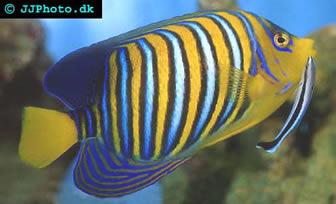Regal Angelfish
Pygoplites diacanthus
Pygoplites diacanthus is known as Regal Angelfish, Royal Angelfish and Royal Empress Angelfish in English.
Pygoplites diacanthus has not been evaluated for the IUCN Red List of Threatened Species.
Geographical range, habitat and habits
The Regal Angelfish lives in the Indo-Pacific. Its geographical range stretches from East Africa and the Red Sea to the Tuamotus Archipelago in French Polynesia. The northern limit is found in the waters of the Japanese Ryukyu and Ogasawara islands, while the range proceeds southwards down to Australia's Great Barrier Reef and New Caledonia.
The Regal Angelfish inhabits parts of lagoons and seaward reefs where the coral growth is prolific. Its depth range is 1-48 meters / 3-157 feet and it occurs singly, in pairs and (rarely) in groups. This species appreciate environments where it can duck in and out of crevices and similar hiding spots. The hiding spots must have good circulation.
Size and appearance
The largest scientifically measured Regal Angelfish was 25.0 cm / 9.8 in.
The sides of the body feature alternating dark-edged bluish white and orange stripes. In the dorsal fin, these stripes become narrower and angle backward. The posterior portion of the dorsal fin is black and adorned with close-set blue spots. The posterior portion of the anal fin sports alternating yellow and blue bands that run parallel to the body contour. The caudal fin is yellow.
In juvenile fish, you can see an eye-spot on the basal portion of the soft dorsal fin. Except for this they look similar to older fish, but the yellow colour on the body leans more towards orange than true yellow.
Regal Angelfish care
The Regal Angelfish is a sensitive species and it is only recommended for devoted and advanced aquarists. A lot of Regal Angelfishes face premature death in aquariums each year after being purchased by improperly prepared aquarists and/or maltreated by fish catchers and dealers within the aquarium trade. Unfortunately, cyanide is still commonly used when Regal Angelfish is caught in South-East Asia. Generally speaking, it is safer to purchase Regal Angelfish from other parts of the world, such as Australia and the Red Sea, but there are naturally always exceptions.
The Regal Angelfish should only be kept in well established aquariums with proper and stable water quality. Strong water circulation is recommended. It is not advisable to house Regal Angelfish in aquariums smaller than 100 gallons / 375 liters and bigger is better since it is easier to keep the water quality up and stable in an even bigger tank. In addition to volume, length is also important. Don’t keep your Regal Angel in an aquarium smaller than 4 feet / 120 cm in length.
The aquarium should contain plenty of live rock where the Regal Angelfish can graze and a lot of suitable hiding spots. The recommended water temperature is 72-78º F / 22-25.5º C, the recommended specific gravity 1.020-1.025 and the recommended pH-value 8.1-8.4.
The Regal Angelfish is considered reef safe with caution. It likes to nip soft corals, stony corals with large polyps, and clam mantels. It will usually leave somewhat noxious soft corals and stony corals with small polyps alone.
This is a semi-aggressive species. Do not house it together with other angelfish, regardless of species (a compatible pair can however be housed together).
Feeding Regal Angelfish
In the wild, the Regal Angelfish feeds primarily on sponges and tunicates. One of the factors that make it hard to keep is its tendency to refrain from eating in the aquarium.
If your Regal Angelfish refuses to eat, check the water quality and make sure that it has enough hiding spots in the aquarium. Try to entice it by serving live or fresh shrimps and freshly opened clams. Don’t panic if the fish refrains from eating for a few days or so, but make sure that all conditions are optimal in the aquarium.
When your Regal Angelfish has started to eat, give it meaty food at least once a day. You can for instance serve shrimps, squid, crabs and clams. It doesn’t have to be live; the Regal Angelfish will typically accept both fresh and frozen food. You can for instance chop up squids to make each piece more suitable in size. Some specimens will even start eating dry food, but it is not advisable to let dry food become the staple food for this species.
In addition to meaty foods, your Regal Angelfish needs at least one serving of algae/vegetable food per day. You can for instance give it marine algae, spirulina, spinach, lettuce and the inner content of green peas. If you can’t find algae in your local fish store, try a shop that sells oriental food because they will often have several types of algae intended for human consumption.
Last but not least, purchase a high-quality angelfish preparation that contains sponge material.
The Regal Angelfish is a browsing species and it is therefore much better to give it many small portions of food throughout the day than serving it one or two large meals per day.
Breeding Regal Angelfish
The Regal Angelfish is an egg-laying species the scatters the eggs.
Marine Angelfish Articles:
African Flameback Angelfish – Centropyge acanthops
Asfur Angelfish – Pomacanthus asfur
Bicolor Angelfish – Centropyge bicolor
Blueface Angelfish – Pomacanthus xanthometopon
Cherub Angelfish – Centropyge argi
Coral Beauty – Centropyge bispinosa
Emperor Angelfish – Pomacanthus imperator
Flame Angelfish – Centropyge loricula
French Angelfish – Pomacanthus paru
Herald's Angelfish – Centropyge heraldi
Koran Angelfish – Pomacanthus semicirculatus
Lamarck's Angelfish – Genicanthus lamarack
Potter's Angelfish – Centropyge potteri
Queen Angelfish – Holacanthus ciliaris
Rock Beauty Angelfish – Holacanthus tricolor
Rusty Angelfish – Centropyge ferrugata
Watanabe's Angelfish – Genicanthus watanabei

